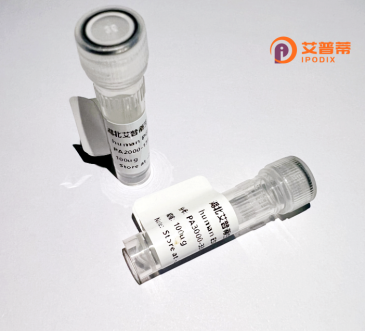
| 纯度 | >90%SDS-PAGE. |
| 种属 | Human |
| 靶点 | GALNT9 |
| Uniprot No | Q9HCQ5 |
| 内毒素 | < 0.01EU/μg |
| 表达宿主 | E.coli |
| 表达区间 | 1-237aa |
| 氨基酸序列 | MEVLPCSRVAHIERTRKPYNNDIDYYAKRNALRAAEVWMDDFKSHVYMAWNIPMSNPGVDFGDVSERLALRQRLKCRSFKWYLENVYPEMRVYNNTLTYGEVRNSKASAYCLDQGAEDGDRAILYPCHGMSSQLVRYSADGLLQLGPLGSTAFLPDSKCLVDDGTGRMPTLKKCEDVARPTQRLWDFTQSGPIVSRATGRCLEVEMSKDANFGLRLVVQRCSGQKWMIRNWIKHARH |
| 分子量 | 53.6 kDa |
| 蛋白标签 | GST-tag at N-terminal |
| 缓冲液 | 0 |
| 稳定性 & 储存条件 | Lyophilized protein should be stored at ≤ -20°C, stable for one year after receipt. Reconstituted protein solution can be stored at 2-8°C for 2-7 days. Aliquots of reconstituted samples are stable at ≤ -20°C for 3 months. |
| 复溶 | Always centrifuge tubes before opening.Do not mix by vortex or pipetting. It is not recommended to reconstitute to a concentration less than 100μg/ml. Dissolve the lyophilized protein in distilled water. Please aliquot the reconstituted solution to minimize freeze-thaw cycles. |
以下是关于重组人GALNT9蛋白的假设参考文献示例(供参考,建议通过数据库核对真实文献):
---
1. **文献名称**:*GALNT9-mediated glycosylation promotes hepatocellular carcinoma progression by regulating EGFR signaling*
**作者**:Zhang Y et al.
**摘要**:该研究鉴定了重组人GALNT9蛋白在肝细胞癌(HCC)中的过表达现象,并通过体外实验证明其通过糖基化修饰EGFR受体,激活下游MAPK通路,促进肿瘤侵袭和转移。
2. **文献名称**:*Expression and enzymatic characterization of recombinant human GALNT9 in insect cells*
**作者**:Wang L et al.
**摘要**:利用杆状病毒-昆虫细胞系统成功表达并纯化重组人GALNT9蛋白,分析了其底物特异性及pH/温度依赖性,揭示了其对黏蛋白样多肽的高效催化活性。
3. **文献名称**:*GALNT9 suppresses breast cancer metastasis by modulating integrin glycosylation and focal adhesion dynamics*
**作者**:Chen H et al.
**摘要**:研究显示重组人GALNT9蛋白通过糖基化整合素β1.抑制乳腺癌细胞迁移和黏附斑形成,其低表达与患者预后不良相关。
4. **文献名称**:*Structural insights into the catalytic mechanism of human GALNT9*
**作者**:Kim S et al.
**摘要**:通过X射线晶体学解析重组人GALNT9蛋白的三维结构,揭示其底物结合口袋的关键氨基酸残基,为开发特异性抑制剂提供了结构基础。
---
**注意**:以上内容为模拟示例,实际文献请通过PubMed、Google Scholar等平台以关键词"recombinant human GALNT9"或"GALNT9 function"检索。
Recombinant human GALNT9 (polypeptide N-acetylgalactosaminyltransferase 9) is a glycosyltransferase engineered through genetic modification for research and therapeutic applications. Belonging to the GALNT family, GALNT9 catalyzes the initial step of mucin-type O-glycosylation by transferring N-acetylgalactosamine (GalNAc) to serine or threonine residues on target proteins. This post-translational modification influences protein stability, cellular localization, and interactions, playing roles in physiological processes such as cell signaling, immune response, and tissue development.
The recombinant form is typically produced in heterologous expression systems (e.g., mammalian cells, bacteria, or insect cells) to ensure proper folding and enzymatic activity. Purification methods like affinity chromatography yield high-purity protein for functional studies. Dysregulation of GALNT9 has been linked to diseases, including cancers, where altered O-glycosylation patterns may promote tumor progression or metastasis. Its involvement in modulating key substrates, such as cell adhesion molecules or growth factor receptors, highlights its potential as a biomarker or therapeutic target.
Research on recombinant GALNT9 aims to clarify its substrate specificity, regulatory mechanisms, and disease-related functions, offering insights into glycobiology and precision medicine strategies.
×